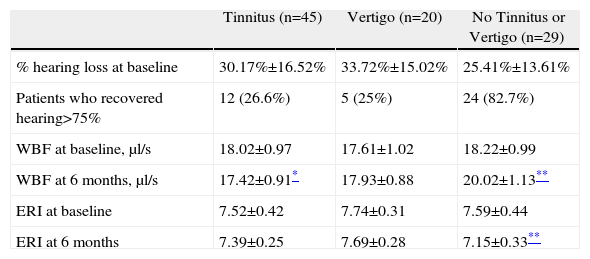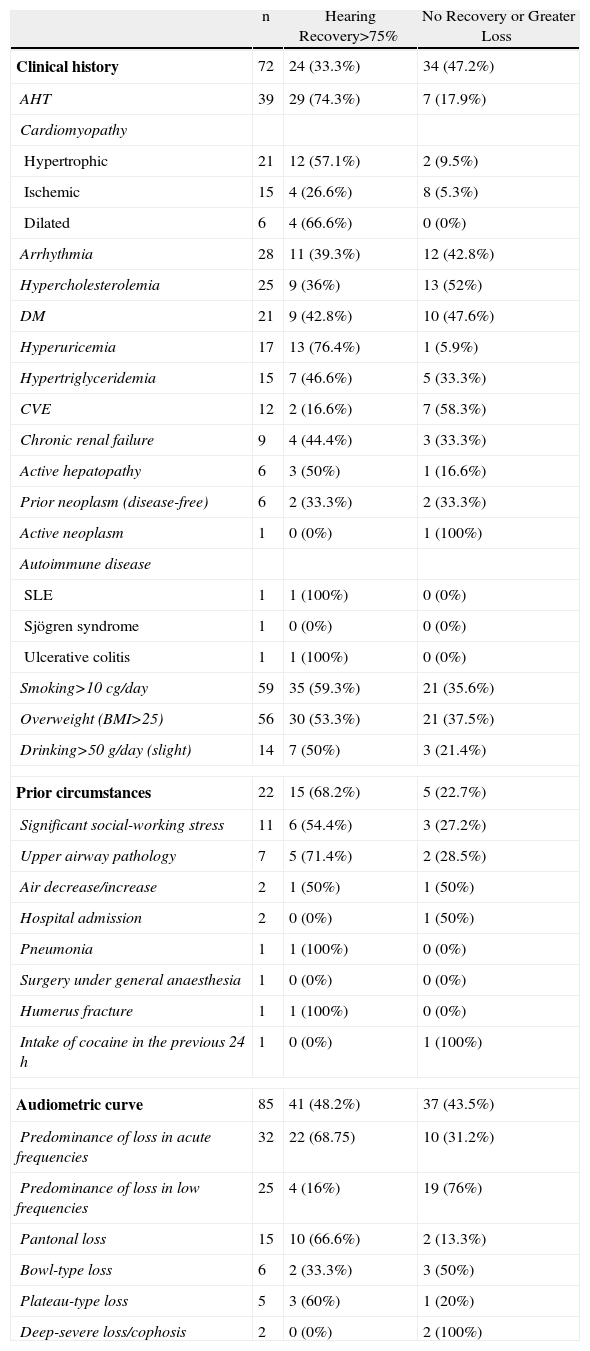To evaluate if viscoelastic properties of blood influence suffering sudden sensorineural hearing loss and the capacity to respond after a specific therapy.
Patients and methodsA longitudinal prospective study included 85 ears bearing sudden deafness. In them, the mean hearing loss compared to the healthy ear and the recovery ratio were measured at the onset and 6 months after a treatment with corticoids and piracetam. In addition, tinnitus or vestibular symptoms, whole blood filterability (WBF) and erythrocyte deformability–by means of the erythrocyte rigidity index (ERI)–were determined and noted at the beginning and the end of the study.
ResultsMean hearing loss was 30.3%±19.7% at the onset, and 25.8%±39% at the end. Forty-one ears showed a recovery of more than 75%. In these (48% of the entire study group), an increase in WBF and a decrease in ERI were observed (P<.001). Ears without tinnitus or vestibular crisis recovered more hearing at 6 months and showed a significant improvement in WBF and ERI, not detected among patients with these clinical findings. There were good correlations between mean hearing loss at onset and WBF, and between recovery and ERI at 6 months, but without statistical significance. Arterial hypertension, cardiopathy and hypercholesterolemia were the most frequently detected diseases in patients, while hypertension and hyperuricemia showed a better hearing recovery ratio.
ConclusionsThe blood viscosity parameters WBF and ERI offer useful information about the risk of suffering sudden deafness and the capacity to recover hearing with reactive therapies.
Evaluar si las propiedades viscoelásticas de la sangre influyen en la posibilidad de padecer sordera súbita o en la capacidad de responder a un tratamiento específico.
Pacientes y metodosFueron estudiados 85 oídos de pacientes con sordera súbita, midiéndose el porcentaje de hipoacusia al inicio y el grado de recuperación a los 6 meses tras un tratamiento con corticoides y piracetam. También se anotó la presencia de acúfeno o síntomas vestibulares y se determinó en sangre periférica la filtrabilidad en sangre total (FST) y el índice de rigidez eritrocitaria (IRE).
ResultadosLa pérdida media al inicio clínico fue del 30,3±19,7% y a los 6 meses del 25,8±39%. En 41 oídos se observó una recuperación auditiva superior al 75% pasado este tiempo. En este grupo –el 48% del total– la FST se elevó y el IRE descendió (p<0,001 en ambos). Los oídos sin acúfeno ni vértigo recuperaron más audición a los 6 meses y mostraron mejoría significativa en su FST y en el IRE. El grado de hipoacusia al inicio se correlacionó con la FST y el de recuperación con el IRE, pero de forma estadísticamente no significativa. Los antecedentes de hipertensión arterial, cardiopatías e hipercolesterolemia fueron los más comúnmente detectados. Hipertensión e hiperuricemia mostraron mayor capacidad de recuperación.
ConclusionesLos parámetros de viscosidad sanguínea FST e IRE se correlacionan bien con el riesgo de padecer sordera súbita y la capacidad de una adecuada recuperación de la misma con terapias reoactivas.
Artículo
Comprando el artículo el PDF del mismo podrá ser descargado
Precio 19,34 €
Comprar ahora










